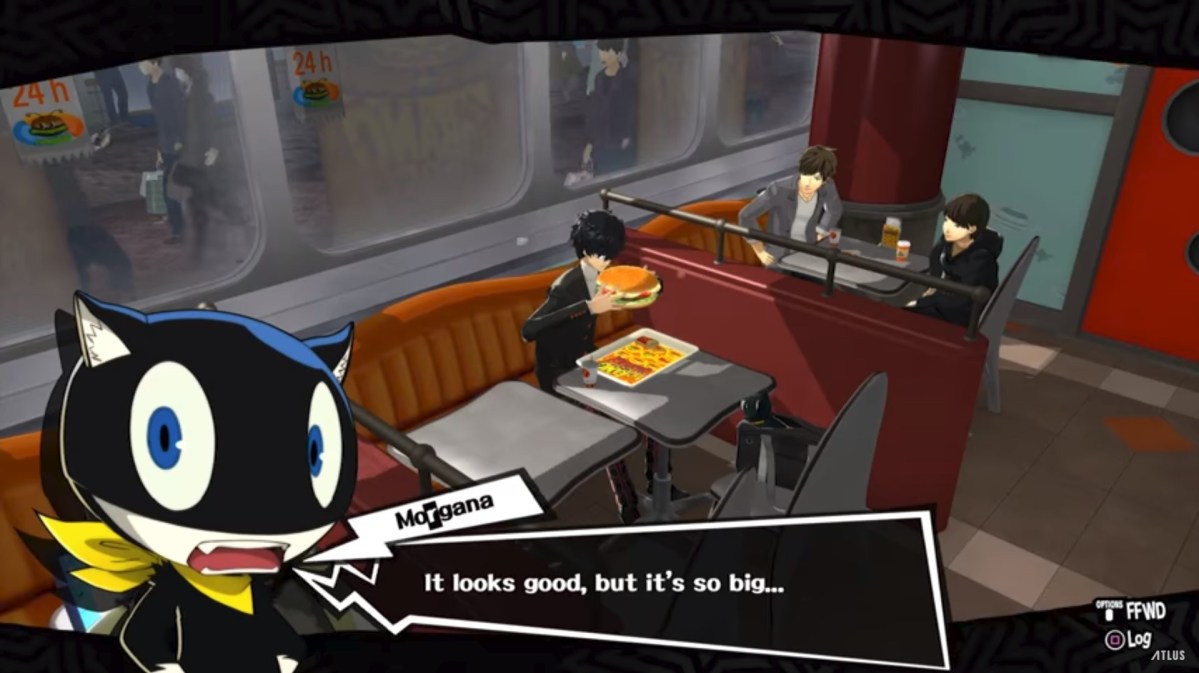You’ll see it coming
One of the most important rules in storytelling is to show, not tell. Actions speak louder than words because it’s more convincing to see somebody act out a storyline than to have them face the camera and recite every letter of their thought process. Yet Persona 5, which is unanimously acclaimed for its writing, takes the most over-explanatory approach to storytelling I’ve seen out of any GOTY nominee from last year. That’s not to say I believe it shouldn’t be so acclaimed. Heck, it’s easily my favorite RPG from last year, for reasons including that story! But that aspect felt like a head-scratching paradox. What did Persona 5 do to break this rule and still succeed so well?
During my Palace-heisting days, I sometimes felt that the dialogue was hammering every single main plot point into my head, no matter how long ago I already got it. Characters constantly discuss the nature of the Metaverse and its symbolic manifestations of how others view the world. Every plot dump is followed up by a text message recapping that same plot dump. It feels as if the characters take too much time to over-explain things. When at its worst, all of this explaining feels patronizing. I might be nitpicking at a story I love, but it’s enough to make me occasionally lose interest or want to skim text.

And yet, I remained strongly invested in my Phantom Thievery. Why? The issue with “tell, don’t show” storytelling is that it cheapens the belief of a given character or event by failing to demonstrate their existence other than ‘because I told you so.’ Persona 5 doesn’t use its prolonged explanations to present the existence of these plot points, but rather, to bring attention to them after they’ve already had an established presence. Every example I can think of where the game’s explanations felt stuffed and padded only came after the very events being explained. Maybe the explanations were a little excessive, but they didn’t take away from the show of those events unraveling before my eyes.
I missed much of this on my playthrough, but many of the game’s bigger plot events are heavily foreshadowed through things that are easy to shrug off as environmental flavor. I don’t want to spoil them, but to vaguely point out examples, consider paying attention to the NPCs around town and what they say or do during free time. They regularly set up seemingly inconsequential events that later become driving forces in the plot. Persona 5 takes a “show first, then tell” approach.
It helps that the Confidant storylines, which are heavily dependent on choices you make during them, don’t feature such heavy-handed explanations until the very end. At that point, the explanations are simply characters reflecting on their recently resolved conflicts, which is far easier to swallow. Unlike the main story, I never felt like the dialogue was overstuffed, which helps to moderate the pacing of this 100+ hour monster of a game.

As an example on the opposite end of this spectrum, Dark Souls fans scarcely recommend the series to others by virtue of its story, or anything other than its gameplay. Yet among themselves, the series’s narrative is one of their favorite points of discussion. While there’s relatively little to see of the plot just playing through the game, items are littered with meaningful flavor text. By following connections between these items and other secrets, the Dark Souls fanbase has been able to infer a deep understanding of relationships and events that are scarcely witnessed within the main dialogue.
This is to show and never tell. It requires players to go out of their way and put effort into seeing a hidden narrative, otherwise their experience is an almost entirely gameplay-driven one. And it’s an excellent approach, allowing players the liberty to delve as much or as little into it as they wish. However, this narrative isn’t even considered a selling point for the series. Dark Souls pushes its gameplay first and foremost. It’s definitely to the series’s overall benefit, but this makes it a much harder recommendation for dark gothic enthusiasts who prefer story over challenging gameplay.
A subtle narrative can be much stronger and more exciting to its audience, but it also scarcely reaches out to as wide of an audience as an unsubtle one. Not that a story needs to reach out to as many people as possible (niches exist for good reasons), but if a work is built with that as its main goal? It may be counterproductive to exclude part of an audience, even if unintentionally, by walling all of the compelling parts of a story behind subtlety. That’s why you rarely hear people complain about the stories of Dark Souls games. Their main goals are to provide challenging gameplay, and the narrative is simply icing on top of the cake.
Contrasting these games, does the rule “show, don’t tell” still have merit? Of course it does! I’m looking into how this affects a narrative’s popularity, not it’s quality. The hidden story within Dark Souls has won the respect of countless gamers… including myself, and I don’t even play it! But having been personally moved by many a video game story, I’m compelled to explore and understand how the best of these works might reach more people. If it’s good, a story deserves to reach more people, doesn’t it?

A great story is often crafted around a meaningful message that can positively impact the lives of those who read it. Persona 5 came out to an audience of young adults who resonated with a message of clinging desperately to hope in their future and fighting abuse. It drew in the huge audience it did for many reasons, but if it didn’t deliver that message so loudly? A lot of people might be in a much worse place of mind today. That’s why I respect Atlus for using this story like a jackhammer instead of a screwdriver.
So perhaps the true lesson to learn from the old adage isn’t “show, never tell,” but rather “show, then tell sparingly.” An engaging story needs hooks to invest its audience, something interesting enough to provoke attention. If just a few such hooks are placed out in the open, readers are more willing to follow the lines deeper into the story. From that point on, even an audience who would otherwise ignore parts of the story may engage with deeper, less obvious hooks.
But that’s just my reflection on my own nitpicking. Whether it hits like a hummingbird or a truck, Persona 5‘s story remains one of my favorites in recent gaming history. What are your favorite stories with subtle devices that required you to probe deeper into them? How about those which are up-in-your-face and direct about everything? On the other hand, are there any you hated because they explained too much or too little?




